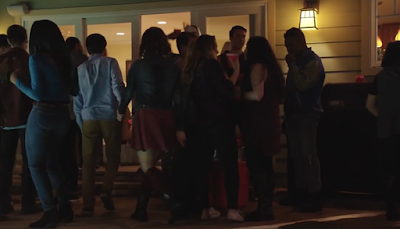Cinematography: Mainly long shots to fit the full scope of the images, paintings and characters on screen as the film combines both stop motion animation and live action. These long shots also allow the viewer to see the full frame, meaning the tense and scary atmosphere of the film is not solely being conveyed through cinematography but by other means too.
Zooms are also used throughout to emphasize character's facial expressions. These can also be startling as the characters are all made to look very unsettling and zooming in only furthers that which is probably precisely why Lynch used zooms.
Insert shots of letters of the alphabet are also used throughout seemingly randomly to show how unpredictable the film and narrative is, something Lynch always seems to include in his work.
Mise En Scene: The atmosphere of the film is quite dark and eerie. This is created through many aspects, mainly the visual imigarey with it's muted and dull colours, as well as the stop motion movement of aspects of the film such as letters of the alphabet and the way the paintings seem to warp and change.
Sound: is used in a very typical David Lynch way. Mainly consisting of whooshes and the sound of wind, often with the voices of children saying letters of the alphabet, creating an uncomfortable and creepy mood due to the disembodied child voices with nothing but the backdrop of loud lonely wind.
Narrative: The narrative is, like in any Lynch film, quite hard to follow and decipher. The film does seem to have a clear beginning, middle and end, just with seemingly random pieces spliced throughout, again, adding to the unnatural and uncanny feel of the film. Lynch may be trying to show how the school system shapes students beliefs into the way they want. It shows a little girls mind struggling to accept these teachings, but the school is ejaculating the alphabet into her brain thus killing her own thoughts and ideas which is why she covers her eyes and mouth, then vomits the blood that represents the schools teachings.
Editing: The editing is very strange and Lynchian in this. Often quickly cutting to images of characters faces and letters of the alphabet to emphasise plot points and create an unsettling and unpredictable atmosphere. The stop motion also does this, making the movement feel uncanny and unnatural, further adding to the creepy vibes of the film.
Tile Sequence: A title sequence plays at the end of the film. It is pretty standard, just crediting those involved. The only really personalized aspect is the fact that the title is painted, just like a lot of the film.















